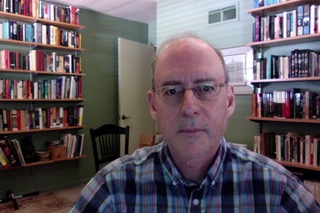It was to Brightside House, a bed and breakfast in Onancock, Virginia, that Paul Eigenstadt came one Friday afternoon in June for a four-night stay. The stresses of his work in the Justice Department on a complex anti-trust case had consumed him for months, undermining both his health and his social life, though he’d been reluctant to leave even now. But his usually steady temperament had suffered as well, and having raised his voice to subordinates three times in the last month, his boss first suggested, then insisted, that he take some time off.
He’d been to the Eastern Shore of the Chesapeake several times before, but never farther south than Chincoteague Island, and found the narrowing, fifty-mile-long portion of the lower Delmarva Peninsula surprisingly rustic, even for the Chesapeake, its small population unchanged for decades, getting by on tourism, oyster and crab harvesting, sport fishing, and farming. Driving through miles of corn, soybean and tomato fields, he was struck by the number of abandoned houses and barns, more than he’d seen anywhere else. Coming from the booming D.C. area, he found this picturesque decay reassuring. Alone, if not by choice, he explored the mostly deserted streets of such dwindling townships as Bloxom, Parksley, Saxis, and Belle Haven, got lost more than once on back roads, and took the ferry to Tangier Island.
He slept soundly two nights in a row, a first for months, and after breakfast on Sunday, he drove to a nearby park his hosts had recommended. He walked through sandy-soiled pine woods and along a shoreline washed by gentle wavelets. Blue crabs side-swam through the shallows, tiny black crabs foraged in drying clumps of seaweed left by the tide, and the rare Northeastern Beach Tiger Beetle, whose vanishing range, a nearby sign informed him, was now limited to a few shores like the one on which he walked, hunted and flew before him, just far enough ahead of his feet to necessitate flying again a second or two later, almost too quick for the eye to follow. The sign was depressing, but the beetles fascinated him, seeming to flicker as they darted, as if giving off sparks. He met no one in the park, for which he was grateful.
That afternoon, he visited a small art gallery on Onancock’s quiet main drag. Most of the paintings, watercolors and photographs were fairly typical examples of regional art: sunsets on the Bay sprinkled with sailboats and traversed by freighters in the background, lighthouses, great blue herons hunting in salt marshes, watermen pulling up crab traps. But he found himself particularly drawn to two works by an artist whose signature was too cryptic to decipher. The larger work, titled The House in Carter’s Field, was a striking oil painting of an abandoned farmhouse, its windows boarded up, moldering alone in a field of high, brown grass, a few bare trees in the background. It evoked a slight, if not unpleasant, chill.
He stood in front of the smaller painting, titled The Bone-House, for almost a minute before the shock of realization gave way to a dream feeling, because he had recognized the figure in the painting as himself, aged twelve, in shorts and t-shirt, standing in front of the massive trunk of a fallen cypress, proudly displaying a seven-foot-long indigo snake he’d just captured while fishing on Peace River. The summer of 1972. He vividly remembered the moment, and who had taken the photograph on which the painting was based: Danea Finch. Now he understood the oddly formed signature, the “D” containing the “F,” followed by “aneainch.” It could be no one else.
He’d grown up with a girl of that name in Jackson Park, Florida. He remembered that, near the end of the time he knew her, she always carried a Brownie Bullet camera on a strap around her neck and was forever snapping pictures. She had given him a print of the snake photo, which he still had in a box somewhere in his basement. She’d been “Danni,” then, the tall, red-headed tomboy of the neighborhood, the only girl he knew who preferred playing baseball or turning over rocks to discover what was lurking underneath to hosting miniature tea parties.
He bought both paintings and asked the owner, a polite, taciturn older lady, for information about the artist. She nodded and handed him a card: Danea Finch, Painting and Photography. There was a local phone number and an email address. “But I should tell you…” the lady began, before the loud crash of a framed photograph jostled from its perch by a woman’s oversized handbag indefinitely claimed her attention, and he soon left.
Back at Brightside House, the two paintings leaning against the wall, he looked at the phone number on the card, trying to decide how badly he wanted to stir the ashes of a long-extinguished friendship.
There were complimentary cocktails at five hosted by the pleasant couple who owned Brightside House, the group that evening composed of two other couples besides himself, he the youngest by far. The topic of conversation as he entered the common room was a local, ongoing criminal investigation of a serial arsonist that he’d read about in the Post. For over a year, someone had been burning down abandoned houses, barns and other outbuildings on Virginia’s Eastern Shore. Local outrage over the authorities’ failure to arrest anyone had been increasing since someone had died in a fire in February. He listened with interest but kept silent.
He dined outdoors that evening at the Dockside Bar and Grill. The cooling fires of sunset found him eating crab bisque, followed by grilled rockfish, the Bay and the perfect weather striving to distract him from his thoughts of the girl he’d known and liked so long ago, and who was apparently here, now, of all places. Though not yet forty, his childhood had in recent years begun to seem as distant as the stars from the overworked lawyer he’d become.
Danni had been with him that summer day on Peace River, pretending to enjoy the bank fishing with cane poles, bobbers and earthworms that he loved, but mostly taking pictures of the dark, slow-moving water, bald cypresses surrounded by upthrusting knees, dead, half-submerged trees crowded with sunning turtles, alligators, the V-wake of an otter crossing the river. The fish weren’t biting, and he’d begun roaming about. The indigo snake had just attacked and all but consumed a fat cottonmouth moccasin—he recognized the truncated, not quite-swallowed tail—and was sluggish and easy to collect in a large grocery sack. Paul had posed for the picture Danni took only a few minutes after the capture, the snake so bloated and docile that it didn’t seem to mind being draped over his shoulders. He had tried to make a pet out of it, but though it regularly drank water, it didn’t eat for two months, and not wanting to be the death of such a lovely creature, he decided to let it go where he’d found it.
He recalled what Danni had said the day she told him that her father, a chemical engineer, had been transferred to Chicago, and they’d be moving soon. “I’m being taken out of my world the way you took your snake out of his.” Thinking about it now, he could date the beginning of his declining interest in collecting reptiles and insects from not long after Danni moved away, which also coincided with the onset of puberty.
For a little while after the move, he had wondered how she was doing, but his family moved to Tampa in the mid-seventies, bringing new people into his life, and he thought of her less often. He wondered over the years what she’d done with her life. Now he knew.
After dinner, as Paul sat in the fading light drinking the last of his carafe of wine, the tables around him mostly empty, he dialed Danni’s number. It was only eight-thirty, he told himself, not too late to call an old friend. That is, if he could still call her an old friend after twenty-seven years of mutual silence. The phone rang several times, and he was about to give up when she answered.
“Hello?” The voice sounded faraway and slightly muffled, reminding him of the way transatlantic phone calls used to sound before the flat immediacy of cell phones erased all sense of distance.
“Hello, am I speaking to Danea Finch?” he asked with a tremor in his voice, his excited heartbeat pounding the blood in his ears.
“Who’s calling, please?
He cleared his throat and said, “This is Paul Eigenstadt.”
“Paul? Is it really you?”
“Yes, Danni. I’m staying in Onancock. How are you?”
“I’m… well. What brings you here?”
“I’d never seen the lower Chesapeake before,” he replied. “I bought two of your paintings at Moorman Gallery today, The House in Carter’s Field and The Bone-House. But it wasn’t until I saw myself in the picture that I knew who the artist was. I always wondered what you’d made of yourself. I like your work very much.”
“It means so much to hear you say that.” Her voice seemed to be slowly vanishing down a drainpipe, though he could still hear every word.
“I still have that picture you took of me at Peace River, the one you based The Bone-House on.”
“Yes, our little date at the river,” she said, and he could hear the smile in her voice. “I remember every detail. What did you do with your life, Paul?”
He told her. “It’s no way to get rich, but it offers the chance to promote the general welfare.”
“I always knew you’d do well.”
He gathered his courage. “The reason why I called, Danni, is I have to go back to D.C. on Tuesday, and I thought if you have any time to spare, we might get together for coffee.”
“That would be wonderful. By the way, Paul, did you marry?”
“No. Did you?”
“In every way but legally, yes. And no, it didn’t last. Now I live alone, painting my pictures.” The signal was getting weaker. He could barely hear her now. “Listen, Paul, would you like to come see me now? I paint all day, so my evenings are free. I’d come to you, but my car’s being repaired.”
“Yes, I’d like that. But the connection’s fading.”
“It’s hard to maintain here,” she said, snowy static almost drowning out her voice. “If you have pen and… I’ll… directions.”
“Just a second.” He took the restaurant pen from the table and turned over his receipt. “Go ahead.” He assured her that he’d be there in half an hour.
“Until…” she said, her voice dying out with the signal.
It was moonless and quite dark when he started out at nine p.m., driving north to Bloxom, then east through Nelsonia—silent villages consisting of a church or two, a few blocks of old, wood-frame houses, and little else—to Modest Town, which lived up to its name, then looked for a narrow paved road called Accomack Trail. At no point had he seen a living soul.
There were two more turns on unnamed dirt roads before he finally stopped at a clearing surrounded on three sides by fields of young corn, the stalks bending in a brisk wind from the ocean side of the peninsula. There was a dim porch light on what had to be Danni’s house.
But could this really be it? he wondered, with a feeling like a sudden drop in altitude on a plane, because he’d recognized the derelict farm house from the painting he’d bought, The House in Carter’s Field. There were the five windows, if no longer boarded, the narrow, warped and weather-streaked front door, the knee-high brown grass—even now, in early summer—and the leafless trees. The chill he’d felt at his first sight of the painting had become a definite uneasiness now. He wondered why she hadn’t told him that she actually lived here.
He mounted the loose wooden steps to the front door and knocked. Already ajar, the door opened halfway, but she wasn’t there to greet him.
“Hello? Danni? Are you home?” he called. “It’s Paul.” He waited, confused and mildly irritated, then pushed the door all the way open and stepped inside. There was an overhead light on in the foyer, which seemed to indicate that she’d been expecting him.
“Hello! I’m here.”
He turned to the right and was startled by Danni, standing there, facing him. But it wasn’t Danni, it was a life-sized painting of her. A self-portrait, he assumed, done in the loose, assured naturalism of The House in Carter’s Field.
The half-smiling figure, with one hand extended in greeting, was almost as tall as he was, and quite slender, her limbs long and graceful, her rather coarse red hair worn much shorter than the thick mane she’d had as a kid. It was still thick, but cut close to her skull, revealing the elegant shape of her head, her long, pale neck with the freckles he remembered, clean jaw and prominent forehead. Her large eyes were a shade of gray that was almost blue, her expression friendly but abstracted, as if her attention were divided between whoever she was greeting and trying to remember a particularly strange dream. She wore tight-fitting jeans, a long-sleeve, button-down black shirt, and sandals. He struggled to assimilate this image of a familiar stranger, to reconcile it with the memory she’d left him with, and as deeply embedded as the rest of his childhood. He was looking at a striking woman in her prime, her beauty emanating most strongly from her fine figure and dreaming eyes rather than her somewhat plain features.
He stepped back from the painting and nearly bumped into the painter, who had silently appeared at his elbow.
“Paul,” she said in a low voice that sounded almost as distant in person as it did on the phone. “You came.” Like the figure in the painting, she extended her hand, and he took it. It was long, sinewy, and very cold.
“Danni. It’s so good to see you.” She was a dramatic contrast to her portrait. Her face had drawn tight around the cheekbones, her large eyes sunken back in their sockets. Her slender figure was gaunt, her shoulders slumped, her short hair threaded with silver, her always-pale but healthy skin now slack and grayish. In what seemed to him an eccentric touch, she was dressed in the same jeans, black shirt and sandals as her painted alter ego.
“Sorry I wasn’t here to greet you. It’s like being on another planet upstairs; you don’t hear anything down here on Earth. Welcome.”
“Thanks.” With her standing so close, he had expected a scent of perfume, but if she was wearing any, it was overwhelmed by a pungent amalgam of oil paint and wood smoke hanging in the air. Unsure about hugging her, he waited for her to set the tone. She, too, seemed tentative, leading him into a single high-ceilinged room with a small, open kitchen in the back and a steep wooden stairway to the upper floor. Whatever inner walls had originally existed on the first floor had been removed, leaving only supporting columns, creating a spacious artist’s studio, lacking only the big windows one would expect to see. The overhead lights were barely sufficient to take in all the details of the room, much less to paint by, which was no doubt why she preferred working by day. Except for the self-portrait in the foyer, the walls were bare.
The burned smell must have come from a recent cooking mishap, since the fireplace clearly hadn’t been used in a while. A paint cloth was spread out near the eastern wall, against which several canvases were stacked, their painted sides hidden. A cloth-covered work in progress rested on an easel with a stool placed in front of it, illuminated by an adjustable desk lamp. Beside the easel was a full brush holder and a paint-smeared wooden pallet. Danni gestured to a small sitting area with a couch and chair. She sat down on the couch, and he took the chair.
Continue to Part Two on August 24th.
About the Author
 Jeffrey Greene was born in Michigan, raised in Florida, and currently lives in Bethesda, Maryland. He has been writing and publishing short stories and the occasional novella since the 1980s. Some of the publications in which his stories have appeared are the North American Review, Tomorrow Speculative Fiction, Oasis, Reactor Magazine, Potomac Review, decomP Magazine, Zahir Speculative Fiction, and most recently, Bewildering Stories.
Jeffrey Greene was born in Michigan, raised in Florida, and currently lives in Bethesda, Maryland. He has been writing and publishing short stories and the occasional novella since the 1980s. Some of the publications in which his stories have appeared are the North American Review, Tomorrow Speculative Fiction, Oasis, Reactor Magazine, Potomac Review, decomP Magazine, Zahir Speculative Fiction, and most recently, Bewildering Stories.
His short story, “The Blind Gambler,” was included in the anthology,“100% Pure Florida Fiction,” in 2000, published by the University of Florida. He has self-published two collections of short stories: Stories From the Cold Room, and The Iron Desert and Other Stories.
![]()






